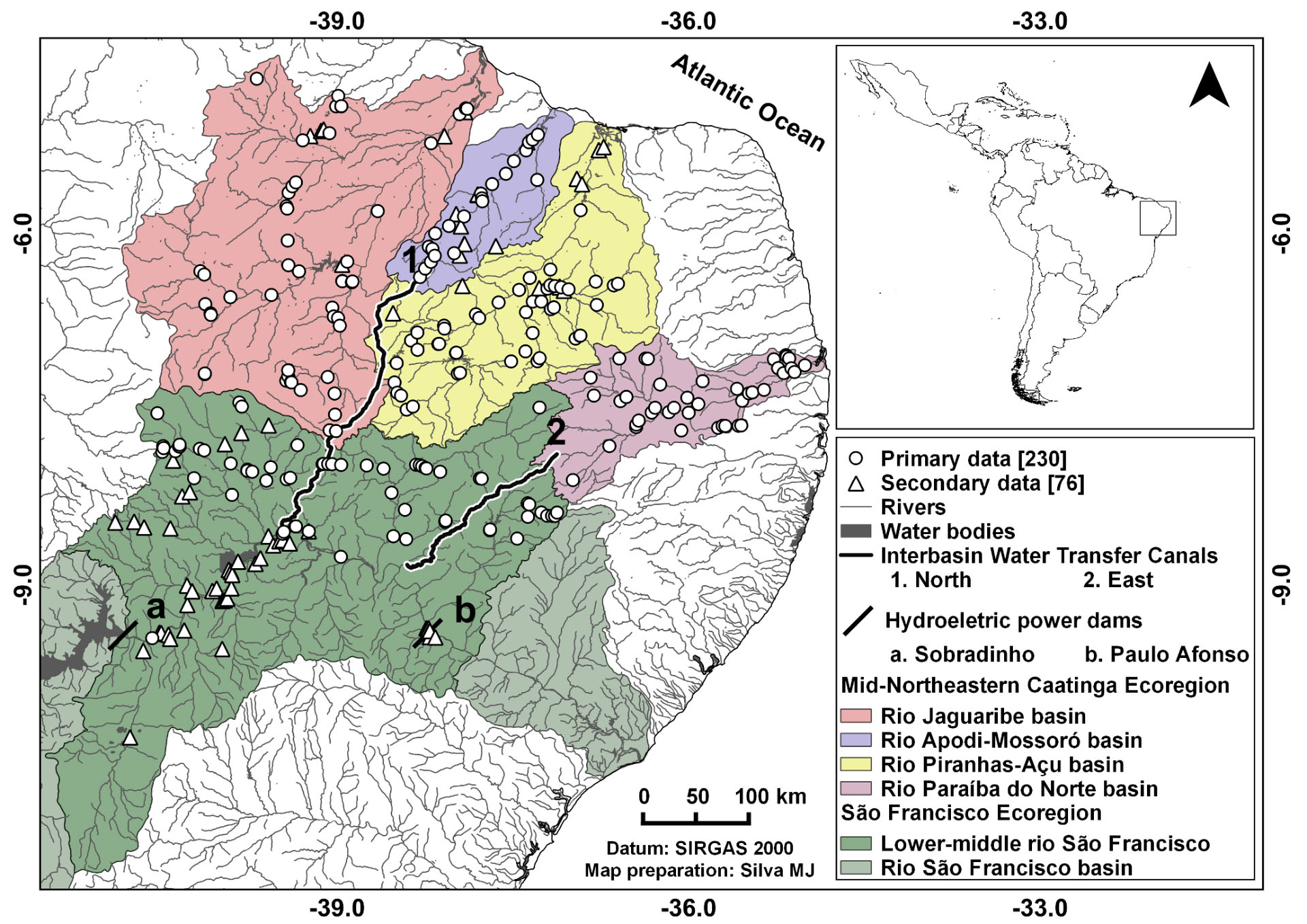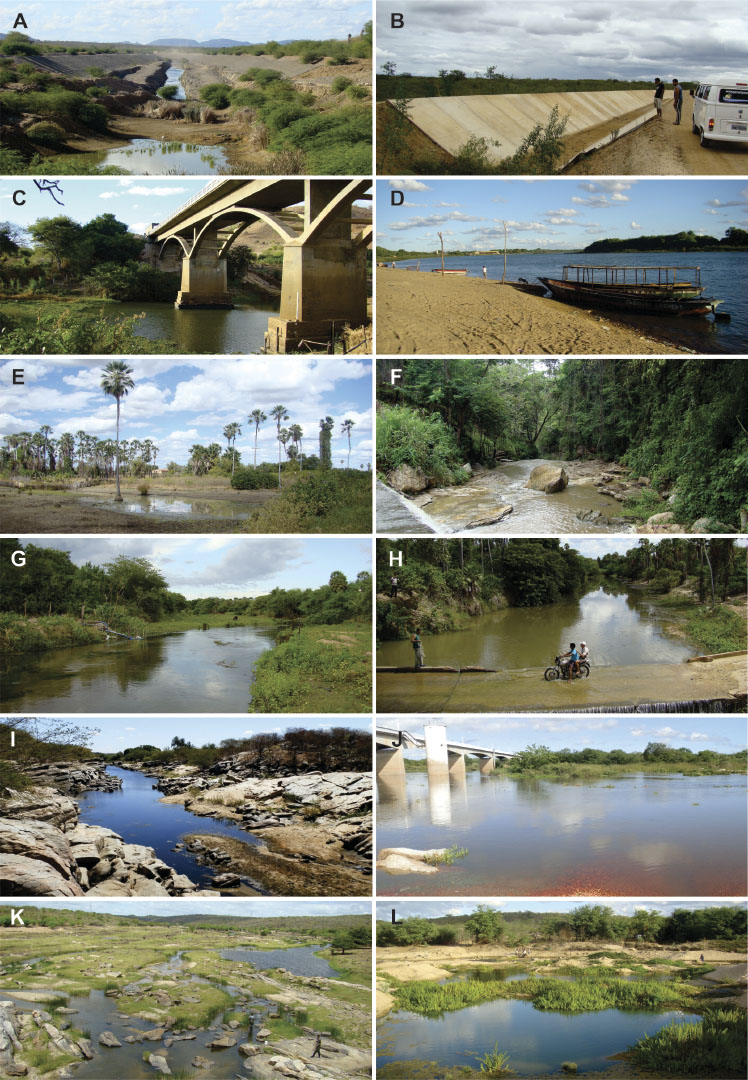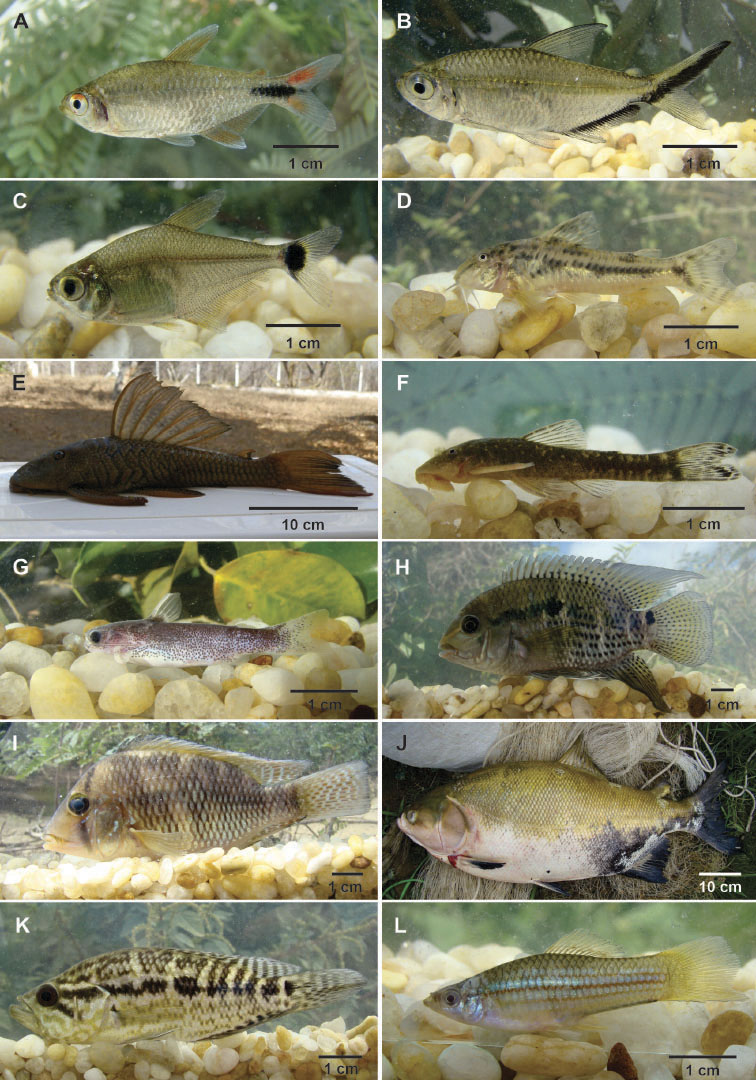| |
SFRE
|
JAG
|
APO
|
PIA
|
PAR
|
Endemism
|
Status
|
|
Osteoglossiformes (1)
|
0 |
1 |
0 |
1 |
0 |
0 |
1 |
|
Arapaimidae (1)
|
|
|
|
|
|
|
|
|
Arapaima gigas (Schinz, 1822) |
|
S |
|
S |
|
|
NNA |
|
Characiformes (62)
|
44 |
30 |
22 |
26 |
22 |
14 |
3 |
|
Crenuchidae (2)
|
|
|
|
|
|
|
|
|
Characidium bimaculatum Fowler, 1941 |
|
P |
P |
P |
P |
|
|
|
Characidium fasciatum Reinhardt, 1867 |
P |
|
|
|
|
|
|
|
Erythrinidae (3)
|
|
|
|
|
|
|
|
|
Erythrinus erythrinus (Bloch & Schneider, 1801) |
|
|
|
|
P |
|
|
|
Hoplerythrinus unitaeniatus (Spix & Agassiz, 1829) |
|
P |
|
|
S |
|
|
|
Hoplias aff. malabaricus (Bloch, 1794) |
P |
P |
P |
P |
P |
|
|
|
Parodontidae (2)
|
|
|
|
|
|
|
|
|
Apareiodon davisi Fowler, 1941 |
|
P |
|
|
P |
MNCE |
EN |
|
Apareiodon hasemani Eigenmann, 1916 |
P |
|
|
|
|
SFRE |
|
|
Serrasalmidae (7)
|
|
|
|
|
|
|
|
|
Colossoma macropomum (Cuvier, 1816) |
P |
|
|
P |
|
|
NNA |
|
Metynnis lippincottianus (Cope, 1870) |
P |
|
|
|
P |
|
|
|
Myleus micans (Lütken, 1875) |
S |
|
|
|
|
|
|
|
Pygocentrus nattereri Kner, 1858 |
|
P |
|
P |
|
|
|
|
Pygocentrus piraya (Cuvier, 1819) |
P |
|
|
|
|
|
|
|
Serrasalmus brandtii Lütken, 1875 |
P |
P |
|
P |
|
|
|
|
Serrasalmus rhombeus (Linnaeus, 1766) |
|
P |
S |
P |
|
|
|
|
Anostomidae (8)
|
|
|
|
|
|
|
|
|
Leporellus vittatus (Valenciennes, 1850) |
S |
|
|
|
|
|
|
|
Leporinus friderici (Bloch, 1794) |
P |
|
|
|
|
|
|
|
Leporinus piau Fowler, 1941 |
P |
P |
P |
P |
P |
|
|
|
Leporinus taeniatus Lütken, 1875 |
P |
P |
P |
|
|
|
|
|
Megaleporinus obtusidens (Valenciennes, 1837) |
S |
|
P |
|
P |
|
NNA (MNCE) |
|
Megaleporinus reinhardti (Lütken, 1875) |
P |
|
|
|
|
SFRE |
|
|
Schizodon dissimilis (Garman, 1890) |
|
P |
|
P |
|
|
|
|
Schizodon knerii (Steindachner, 1875) |
P |
|
|
|
|
SFRE |
|
|
Curimatidae (5)
|
|
|
|
|
|
|
|
|
Curimatella lepidura (Eigenmann & Eigenmann, 1889) |
P |
|
P |
P |
|
|
|
|
Psectrogaster rhomboides Eigenmann & Eigenmann, 1889 |
|
P |
|
P |
P |
|
|
|
Psectrogaster saguiru (Fowler, 1941) |
|
S |
P |
S |
|
MNCE |
|
|
Steindachnerina elegans (Steindachner, 1875) |
P |
|
|
|
|
|
|
|
Steindachnerina notonota (Miranda Ribeiro, 1937) |
|
P |
P |
P |
P |
|
|
|
Prochilodontidae (3)
|
|
|
|
|
|
|
|
|
Prochilodus argenteus Spix & Agassiz, 1829 |
P |
|
|
|
|
SFRE |
|
|
Prochilodus brevis Steindachner, 1875 |
P |
P |
P |
P |
P |
|
|
|
Prochilodus costatus Valenciennes, 1850 |
P |
|
|
|
|
SFRE |
|
|
Triportheidae (2)
|
|
|
|
|
|
|
|
|
Triportheus guentheri (Garman, 1890) |
P |
|
|
|
|
SFRE |
|
|
Triportheus signatus (Garman, 1890) |
P |
P |
P |
P |
P |
|
|
|
Bryconidae (2)
|
|
|
|
|
|
|
|
|
Salminus franciscanus Lima & Britski, 2007 |
S |
|
|
|
|
SFRE |
|
|
Salminus hilarii Valenciennes, 1850 |
S |
S |
|
|
|
|
|
|
Iguanodectidae (1)
|
|
|
|
|
|
|
|
|
Bryconops sp. |
P |
|
|
|
|
|
|
|
Acestrorhynchidae (1)
|
|
|
|
|
|
|
|
|
Acestrorhynchus lacustris (Lütken, 1875) |
P |
|
|
|
|
|
|
|
Characidae (26)
|
|
|
|
|
|
|
|
|
Astyanax aff. bimaculatus (Linnaeus, 1758) |
|
P |
P |
P |
P |
|
|
|
Astyanax lacustris (Lütken, 1875) |
P |
|
|
|
|
|
|
|
Piabarchus stramineus (Eigenmann, 1908) |
P |
|
|
|
|
|
|
|
Cheirodon jaguaribensis Fowler, 1941 |
|
P |
P |
P |
P |
MNCE |
|
|
Compsura heterura Eigenmann, 1915 |
P |
P |
P |
P |
P |
|
|
|
Hasemania nana (Lütken, 1875) |
S |
|
|
|
|
|
|
|
Hemigrammus brevis Ellis, 1911 |
P |
|
|
|
|
SFRE |
|
|
Hemigrammus marginatus Ellis, 1911 |
P |
P |
P |
P |
P |
|
|
|
Hemigrammus rodwayi Durbin, 1909 |
|
P |
|
P |
P |
|
|
|
Hemigrammus unilineatus (Gill, 1858) |
|
|
|
|
P |
|
|
|
Hyphessobrycon cf. parvellus Ellis, 1911 |
|
P |
|
|
P |
|
|
|
Moenkhausia costae (Steindachner, 1907) |
P |
P |
P |
P |
|
|
|
|
Moenkhausia cf. intermedia Eigenmann, 1908 |
|
P |
P |
P |
|
|
|
|
Moenkhausia sanctaefilomenae (Steindachner, 1907) |
S |
|
|
|
|
|
|
|
Orthospinus franciscensis (Eigenmann, 1914) |
P |
|
|
|
|
SFRE |
|
|
Phenacogaster calverti (Fowler, 1941) |
|
S |
S |
P |
|
|
|
|
Phenacogaster franciscoensis Eigenmann, 1911 |
P |
|
|
|
|
|
|
|
Phenacogaster julliae Lucena & Lucena, 2019 |
S |
|
|
|
|
SFRE |
|
|
Piabina argentea Reinhardt, 1867 |
P |
|
|
|
|
|
|
|
Psalidodon fasciatus (Cuvier, 1819) |
P |
P |
P |
P |
P |
|
|
|
Psellogrammus kennedyi (Eigenmann, 1903) |
P |
P |
P |
P |
|
|
|
|
Roeboides xenodon (Reinhardt, 1851) |
P |
|
|
|
|
SFRE |
|
|
Serrapinnus heterodon (Eigenmann, 1915) |
P |
P |
P |
P |
P |
|
|
|
Serrapinnus piaba (Lütken, 1875) |
P |
P |
P |
P |
P |
|
|
|
Tetragonopterus argenteus Cuvier, 1816 |
|
P |
|
|
|
|
|
|
Tetragonopterus franciscoensis Silva, Melo, Oliveira & Benine, 2016 |
P |
|
|
|
|
|
|
|
Gymnotiformes (3)
|
3 |
0 |
0 |
0 |
1 |
0 |
0 |
|
Sternopygidae (2)
|
|
|
|
|
|
|
|
|
Eigenmannia virescens (Valenciennes, 1836) |
P |
|
|
|
|
|
|
|
Sternopygus macrurus (Bloch & Schneider, 1801) |
S |
|
|
|
|
|
|
|
Gymnotidae (1)
|
|
|
|
|
|
|
|
|
Gymnotus aff. carapo Linnaeus, 1758 |
S |
|
|
|
P |
|
|
|
Siluriformes (35)
|
22 |
13 |
5 |
9 |
9 |
17 |
3 |
|
Callichthyidae (7)
|
|
|
|
|
|
|
|
|
Aspidoras menezesi Nijssen & Isbrücker, 1976 |
|
P |
|
|
|
MNCE(JAG) |
|
|
Aspidoras sp. |
P |
|
|
|
|
|
|
|
Callichthys callichthys (Linnaeus, 1758) |
S |
|
|
|
P |
|
|
|
Corydoras garbei Ihering, 1911 |
P |
|
|
|
|
SFRE |
|
|
Corydoras sp. |
|
|
|
P |
|
MNCE |
|
|
Hoplosternum littorale (Hancock, 1828) |
P |
|
|
|
|
|
|
|
Megalechis thoracata (Valenciennes, 1840) |
|
|
|
|
S |
|
|
|
Loricariidae (13)
|
|
|
|
|
|
|
|
|
Hypostomus macrops (Eigenmann & Eigenmann, 1888) |
S |
|
|
|
|
|
|
|
Hypostomus pusarum (Starks, 1913) |
P |
P |
P |
P |
P |
|
|
|
Hypostomus sertanejo Zawadzki, Ramos & Sabaj, 2017 |
|
P |
|
|
|
MNCE |
|
|
Loricariichthys derbyi Fowler, 1915 |
|
P |
P |
|
|
|
|
|
Loricariichthys sp. |
|
P |
|
|
|
|
|
|
Parotocinclus cearensis Garavello, 1977 |
P |
P |
|
P |
P |
|
|
|
Parotocinclus jumbo Britski & Garavello, 2002 |
P |
P |
|
P |
P |
|
|
|
Parotocinclus seridoensis Ramos, Barros-Neto, Britski & Lima, 2013 |
|
|
|
P |
|
MNCE(PIA) |
|
|
Parotocinclus spilosoma (Fowler, 1941) |
|
|
|
|
P |
MNCE(PAR) |
|
|
Parotocinclus spilurus (Fowler, 1941) |
|
P |
|
|
|
MNCE(JAG) |
EN |
|
Pseudancistrus genisetiger Fowler, 1941 |
|
P |
|
P |
|
|
|
|
Pterygoplichthys etentaculatus (Spix & Agassiz, 1829) |
S |
|
|
|
|
SFRE |
|
|
Rineloricaria sp. |
P |
|
|
|
|
|
|
|
Auchenipteridae (3)
|
|
|
|
|
|
|
|
|
Tatia bockmanni (Sarmento-Soares & Buckup, 2005) |
P |
|
|
|
|
SFRE |
|
|
Trachelyopterus cratensis (Miranda Ribeiro, 1937) |
|
P |
|
|
|
|
|
|
Trachelyopterus galeatus (Linnaeus, 1766) |
P |
P |
P |
P |
P |
|
|
|
Heptapteridae (5)
|
|
|
|
|
|
|
|
|
Pimelodella dorseyi Fowler, 1941 |
|
P |
P |
|
|
MNCE |
|
|
Pimelodella enochi Fowler, 1941 |
|
|
|
P |
P |
MNCE |
|
|
Pimelodella laurenti Fowler, 1941 |
P |
|
|
|
|
SFRE |
|
|
Pimelodella robinsoni (Fowler, 1941) |
S |
|
|
|
|
SFRE |
|
|
Rhamdia aff. quelen (Quoy & Gaimard, 1824) |
S |
P |
S |
S |
P |
|
|
|
Pimelodidae (5)
|
|
|
|
|
|
|
|
|
Duopalatinus emarginatus (Valenciennes, 1840) |
S |
|
|
|
|
SFRE |
|
|
Pimelodus fur (Lütken, 1874) |
S |
|
|
|
|
|
|
|
Pimelodus maculatus Lacepède, 1803 |
S |
|
|
|
|
|
|
|
Pimelodus pohli Ribeiro & Lucena, 2006 |
S |
|
|
|
|
SFRE |
|
|
Pseudoplatystoma corruscans (Spix & Agassiz, 1829) |
S |
|
|
|
|
|
|
|
Pseudopimelodidae (1)
|
|
|
|
|
|
|
|
|
Lophiosilurus alexandri Steindachner, 1876 |
P |
|
|
|
|
SFRE |
VU |
|
Incertae sedis (1)
|
|
|
|
|
|
|
|
|
Conorhynchos conirostris (Valenciennes, 1840) |
S |
|
|
|
|
SFRE |
EN |
|
Synbranchiformes (1)
|
1 |
1 |
1 |
1 |
1 |
0 |
0 |
|
Synbranchidae (1)
|
|
|
|
|
|
|
|
|
Synbranchus aff. marmoratus Bloch, 1785 |
P |
P |
P |
P |
P |
|
|
|
Cichliformes (11)
|
11 |
8 |
7 |
8 |
9 |
1 |
6 |
|
Cichlidae (11)
|
|
|
|
|
|
|
|
|
Astronotus ocellatus (Agassiz, 1831) |
S |
P |
P |
P |
P |
|
NNA |
|
Cichla monoculus Spix & Agassiz, 1831 |
S |
P |
P |
P |
S |
|
NNA |
|
Cichla kelberi Kullander & Ferreira, 2006 |
P |
S |
S |
P |
P |
|
NNA |
|
Cichlasoma orientale Kullander, 1983 |
P |
P |
P |
P |
P |
|
|
|
Cichlasoma sanctifranciscense Kullander, 1983 |
P |
|
|
|
|
|
|
|
Coptodon rendalli (Boulenger, 1897) |
P |
S |
S |
S |
S |
|
NNA |
|
Crenicichla brasiliensis (Bloch, 1792) |
P |
P |
P |
P |
P |
|
|
|
Crenicichla sp. |
P |
|
|
|
|
SFRE |
|
|
Geophagus brasiliensis (Quoy & Gaimard, 1824) |
P |
P |
|
P |
P |
|
|
|
Oreochromis niloticus (Linnaeus, 1758) |
P |
P |
P |
P |
P |
|
NNA |
|
Parachromis managuensis (Günther, 1867) |
P |
|
|
|
P |
|
NNA |
|
Cyprinodontiformes (8)
|
5 |
5 |
4 |
2 |
2 |
4 |
3 |
|
Rivulidae (4)
|
|
|
|
|
|
|
|
|
Cynolebias microphthalmus Costa & Brasil, 1995 |
|
S |
S |
|
|
MNCE |
|
|
Cynolebias porosus Steindachner, 1876 |
S |
|
|
|
|
SFRE |
|
|
Hypsolebias antenori (Tulipano, 1973) |
|
S |
S |
|
|
MNCE |
|
|
Hypsolebias flavicaudatus (Costa & Brasil, 1990) |
S |
|
|
|
|
SFRE |
CR |
|
Poeciliidae (4)
|
|
|
|
|
|
|
|
|
Pamphorichthys hollandi (Henn, 1916) |
P |
|
|
|
|
|
|
|
Poecilia reticulata Peters, 1859 |
P |
P |
S |
P |
P |
|
NNA |
|
Poecilia vivipara Bloch & Schneider, 1801 |
P |
P |
P |
P |
P |
|
|
|
Xiphophorus helleri Heckel, 1848 |
|
P |
|
|
|
|
NNA |
|
Total (121)
|
86
|
58
|
39
|
47
|
44
|
36
|
16
|

 Thumbnail
Thumbnail
 Thumbnail
Thumbnail
 Thumbnail
Thumbnail


